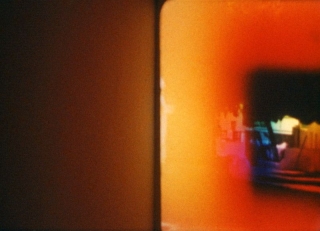To the Winged Distance: Programme 5
Date: 16 February 2007 | Season: Robert Beavers 2007
TO THE WINGED DISTANCE: PROGRAMME 5
Friday 16 February 2007, at 7pm
London Tate Modern
Robert Beavers, Winged Dialogue, 1967/2000
Robert Beavers, Plan of Brussels, 1968/2000, 16mm, colour, sound, 21 min
Winged Dialogue details with growing clarity the desperate beauty and sexuality of the body animated by its soul, essence blindly reaching out, touching, in brilliant patterns through and beyond those of the vanishing images, expressed vividly in the after-image on the mind, on the soul’s eye. (Tom Chomont, a note on Winged Dialogue)
Shedding all traces of narrative, Beavers filmed himself in a hotel room, both at his work desk and lying naked on the bed, while in rapid rhythmic cutting, and sometimes in superimposition, the phantasmagoria of people he met in Brussels and images from the streets flood his mind. (P. Adams Sitney, Film Comment)
Robert Beavers, Still Light, 1970/2001, 16mm, colour, sound, 25 min
The first half of the film explores delicate nuances of lighting, colour and depth as Beavers shoots the face of a young man in various locales on the Greek island of Hydra, using a variety of customized masks and filters. The man’s face remains constant throughout, surrounded by iconic elements in the landscape, like a pulsating Renaissance portrait. Still Light’s second half was shot in the London flat of art critic Nigel Gosling. The two halves of Still Light bring to mind any number of structuralist binarisms: youth and age, creation and criticism, action and reflection, living landscape and mummified text. (Ed Halter, New York Press)
Robert Beavers, Wingseed, 1985, 16mm, colour, sound, 15 min
A seed which floats in the air, a whirligig, a love charm. This magnificent landscape, both hot and dry, is far from sterile; rather, the heat and dryness produce a distinct type of life, seen in the perfect forms of the wild grass and seed pods, the herds of goats as well as in the naked figure. The torso, in itself, and more, the image which it creates in this light. The sounds of the shepherd’s signals and the flute’s phrase are heard. And the goats’ bells. Imagine the bell’s clapper moving from side to side with the goat’s movements like the quick side-to-side camera movements, which increase in pace and reach a vibrant ostinato. (Robert Beavers)
